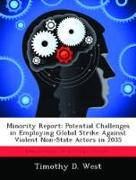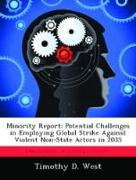- Start
- Minority Report: Potential Challenges in Employing Global Strike Against Violent Non-State Actors in 2035
Minority Report: Potential Challenges in Employing Global Strike Against Violent Non-State Actors in 2035
Angebote / Angebote:
The computing environment of 2035 is projected to be vastly different from that of today. Assuming processing power continues to double every 18 months in accordance with Moore's Law, computers will be 41, 285 times more powerful. Further, the environment will likely be saturated with microchips: in our walls, our furniture, our clothes, and even in our bodies. As a result, many analysts share a common belief that it will be impossible for a clandestine group or individual to hide in such a society-that tomorrow's Osama bin Laden does not have a prayer of staying below the radar for 10 minutes, let alone 10 years. This "minority report" challenges that belief by first showing that the amount of data available to be analyzed is currently growing faster than processing power, and then discussing the challenges and complexities this creates for employing global strike against a violent non-state actor (VNSA) in the 2035 timeframe. It examines each of the six steps of the kill chain (e.g., Find, Fix, Track, Target, Engage, and Assess) and considers the actions a VNSA might employ to block that step. The paper shows that an enemy who can break even one link in the kill chain can effectively thwart global strike, at least temporarily. Further, the earlier the VNSA breaks the chain, the more likely his survival, with the ideal being to break the chain before the enemy can even find the VNSA. The author concludes that the key to a successful global strike against a VNSA in 2035 is the intelligence that enables the strike, and not the strike weapon itself. Thus, he recommends the Air Force continue to invest in a full spectrum of intelligence, surveillance, and reconnaissance technologies.
Folgt in ca. 15 Arbeitstagen


